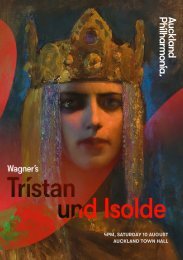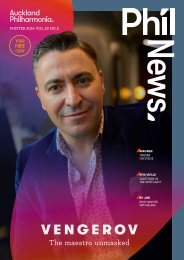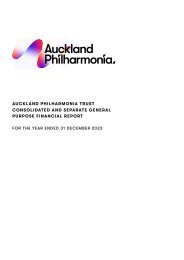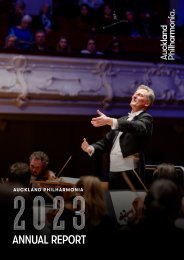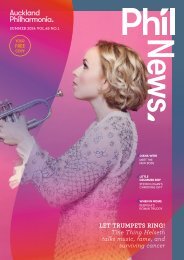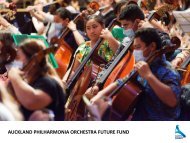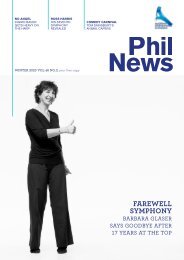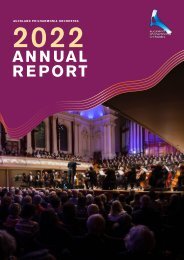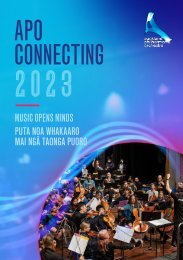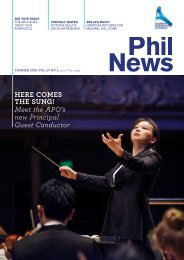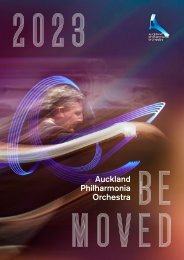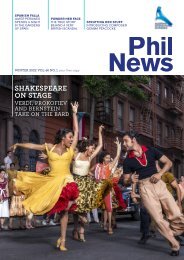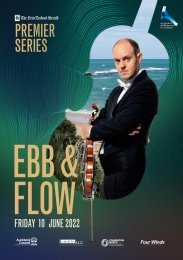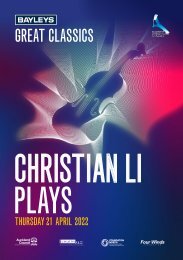You also want an ePaper? Increase the reach of your titles
YUMPU automatically turns print PDFs into web optimized ePapers that Google loves.
JOHANNES<br />
BRAHMS<br />
(1833 – 1897)<br />
COMPOSER PROFILE<br />
• Considered to be the leading composer of the<br />
Romantic period of music<br />
• Composed a piano sonata at age 11<br />
• Made his public debut as a conductor at age 14<br />
• Introduced to Gypsy music by Hungarian violinist<br />
Eduard Remenyi<br />
• At the age of 30, he accepted the directorship of the<br />
Vienna Singakademie<br />
• Brahms died of cancer at age 64. On the day of his<br />
funeral, all the ships in Hamburg lowered their flags to<br />
half-mast<br />
VIOLIN CONCERTO<br />
Brahms’ Violin Concerto was composed in 1878 and first<br />
performed in Leipzig, Germany. Piano and violin were the<br />
most popular solo instruments for concertos throughout<br />
the Romantic period.<br />
This piece was composed for Brahms’ friend and virtuoso<br />
violinist, Joseph Joachim. It was considered too difficult to<br />
play as it included rapid broken chords, scales and doublestopping.<br />
However, Brahms believed in Joachim’s abilities,<br />
and the Concerto was intended for Joachim to show off<br />
his virtuosity.<br />
<strong>The</strong> concerto features a cadenza at the end of the first<br />
movement, and Brahms was one of the last composers to<br />
allow the soloist to improvise it. This is because soloists<br />
began to create very long cadenzas, and eventually,<br />
composers would notate their cadenzas so that they had<br />
more control over the material that was performed.<br />
<strong>The</strong> concerto has three movements:<br />
I. Allegro non troppo<br />
II. Adagio<br />
III. Allegro gigocoso ma non troppo vivace<br />
<strong>The</strong> first movement is in Sonata form. It starts with a long<br />
introduction and the first theme presented by the orchestra.<br />
Next, the theme develops and moves into a quiet section<br />
which leads to the second theme. After this second<br />
theme, the solo violin finally enters, taking us through the<br />
development and exposition before the solo violin plays the<br />
cadenza, leading us to the final coda section.<br />
<strong>The</strong> second movement has three sections. <strong>The</strong> first section<br />
begins with the melody in the solo oboe, accompanied by<br />
the orchestra. <strong>The</strong> solo violin then takes over the melody,<br />
and this moves us into the passionate second section.<br />
Finally, the orchestra returns with the first section melody<br />
and solo violin to round off this movement.<br />
<strong>The</strong> last movement is in rondo form, where the ‘A’ section<br />
of music keeps returning. <strong>The</strong> A section begins with a<br />
foot-stomping Hungarian-style theme, with the solo violin<br />
underneath. <strong>The</strong> B section starts with light solo violin and<br />
accompaniment. This turns into a series of legato scales,<br />
in which the solo violin brings in another rhythmic melody<br />
before returning to the A section.<br />
Section C begins with graceful arpeggios followed by the<br />
solo violin playing fragments from the B section before<br />
playing the main melody from section A. <strong>The</strong> coda starts<br />
with a faster tempo in a lively Turkish style in 6/8, ending<br />
with strong subito forte, staccato chords.<br />
DID YOU KNOW?<br />
Brahms began composing when he was only 11 –<br />
however, he was embarrassed by these early compositions<br />
and he destroyed all of those works as he grew older.<br />
2



